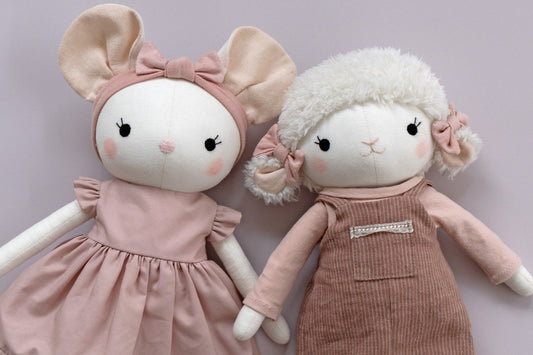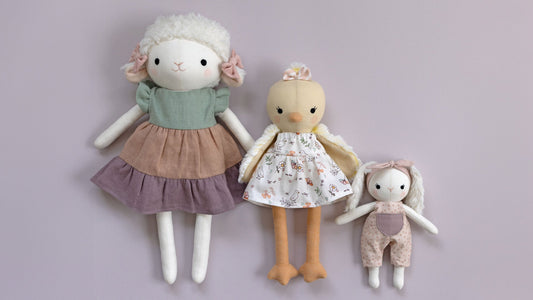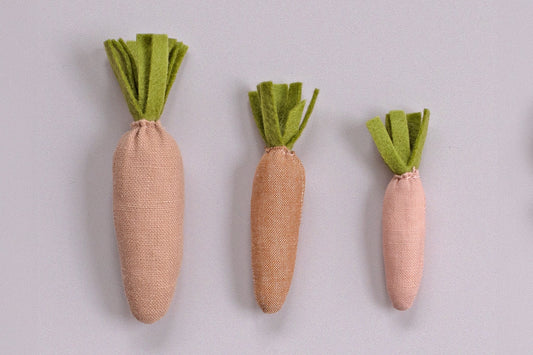When you first start making dolls it is easy to make mistakes, especially if you are a beginner. I’ve made many myself over the years! In this post, I share the most common doll making mistakes I see and share some tips to help you avoid them.
1. Not using enough stuffing
The number one mistake I see people make when they begin making dolls is not using enough stuffing. You need to use a lot more than you first imagine! When a doll is stuffed well it is firm and smooth. When it is stuffed poorly it is lumpy in some places and hollow in others. Not using enough stuffing can lead to your doll having a floppy neck and hollowed cheeks. It also makes it harder to embroider the doll's face because the fabric will not be as taut.

In my doll sewing patterns, I share the steps I take to stuff a doll’s body. When you buy a pattern you are invited to join a private Facebook group where you can watch a video of me stuffing a doll to see how much stuffing I use.
2. Using poor quality materials
When you first start making dolls the number of different materials available can be overwhelming. It can be hard to know which fabrics and threads are good quality if you haven’t used them before and don't have anything to compare them to.
One mistake to avoid is using fabric for the doll’s body that is too thin. A good rule to follow is if you can see your hand through the fabric, don’t use it! If the fabric is too thin it could tear when you stuff the body. Your seams might also show through the fabric when the doll is stuffed.
One of the most frustrating mistakes you can make is buying cheap thread that is thin and breaks easily. Not only will you find yourself rethreading your machine all the time (and no one likes to do that!), but the seams might burst when you stuff your doll’s body.
Cheap stuffing is another mistake that can lead to lumpy dolls that don't hold their shape so well over time.

If you spend hours making a doll, the last thing you want is for it to fall apart. If you are a beginner or new to doll making you can read more about the materials I use here.
3. Not using the correct body fabric
A mistake I often see people make is not using the body fabric recommended by the doll sewing pattern. It can be tempting to use different types of fabrics than those recommended (especially when you find them in pretty colours or textures!), but the recommended fabrics will have been carefully chosen to ensure your finished doll is a certain shape and that their clothes will fit this shape.
If, for example, you use a knitted fabric such as jersey, fleece or plush/minky to make the doll’s body when a pattern recommends using a woven fabric such as cotton or linen your doll will be a different shape from the one in the pattern. The body might be taller or wider in places.
Knitted fabric is much stretchier than woven fabric because it is made differently. Woven fabric is made on a loom. Threads are woven over and under each other at right angles, similar to how a basket is made. The resulting fabric is tight with little give or stretch. Knitted fabric is made with one continuous thread that is looped repeatedly to create what looks like tiny rows of braids. This makes it much more flexible and stretchier. When you make clothes or other crafts, you can sometimes get away with using woven and knit fabrics interchangeably. This isn't the case with doll making because you are stuffing the doll’s body...and the more you stuff knitted fabric, the more it stretches!
An easy way to identify whether a fabric is woven or knitted is to apply a stretch test. When you pull a knit fabric along its width, it will stretch a lot! It will also stretch lengthways, but not as much.

Most woven fabrics don't stretch along the length of the fabric, and there is only minimal give if you pull it widthways. In the photo below I'm stretching cotton fabric.

Another way to check is to take a handful of fabric in the ball of your hand and squeeze it. A knit fabric will crush easily, but when you release your hand it springs back into shape with few, if any, wrinkles. If you do the same with woven fabric, it will easily wrinkle as you can see from the photos below.


Read more about the fabrics I recommend using for my doll sewing patterns
4. Cutting the pattern out incorrectly
Doll sewing patterns usually include a recommended cutting layout and pattern pieces indicate the direction they should be placed in relation to the selvedge (the edge of the fabric that runs lengthwise and sometimes contains information about the fabric). The stretch of the fabric and how strong it is depends on the direction it is pulled.

If you cut the pieces the wrong way, your doll may distort or be the wrong shape when it is stuffed. If you have ever made a doll that is taller or wider than expected, this could be the reason!
5. Lopsided arms and ears
Some doll sewing patterns are designed so that the arms and ears (if you are making an animal) are sewn into the doll’s body before you stuff it. This makes attaching them quick, but if they aren’t held in place properly or move while you sew them, they can end up uneven. Sometimes you might not notice this until you have stuffed the doll, at which point it is a big mistake to fix. A bunny with lopsided ears can be charming, but if the doll’s arms aren’t even this can affect how well their clothes fit.

I design my sewing patterns so that the arms and ears are hand-sewn to the body after it has been stuffed. There is much less room for mistakes this way because you can see where the arms and ears are positioned before you sew them into place. If you make a mistake, it is easy to fix with a little unpicking.
6. Not pressing seams
Pressing seams might feel like a pain, but it makes a big difference to the shape of your doll and how well made it looks. When you press a seam, you place a steam iron down on the material and lift it rather than slide it across the fabric like you do when you want to remove wrinkles.

This makes the stitches meld into the fabric so that they are flatter and less noticeable. The body will be smooth and well shaped, giving it a professional, polished look. Pressing seams when you make the doll’s clothes is equally important. It gives them that crisp look that store-bought clothing has.
I hope you found these tips helpful. With doll making, mistakes are part of the learning process. We all make them. Don’t let them discourage you. Instead, learn from them and use them to make your sewing better. When you make a mistake, you are less likely to repeat it! Every doll you make gets easier and easier.
I spend a lot of time remembering the mistakes I made when I first started making dolls and the questions I had so I can answer them in my doll patterns. They are much more detailed than traditional sewing patterns and are filled with tips and tricks to make sewing your first doll as easy as possible.

What mistakes have you made when sewing dolls? Are there any doll making tips you wish you had known when starting out that beginners would find useful? Let me know in the comments below!
If you enjoyed this post why not read about my top doll making tips.

Pin this image save these tips to Pinterest





5 comments
I have a doll pattern and working on the body, its say make one with knit and one woven. I have never done this before and it says to ‘Dress’ the woven body with the knit body.. I don’t understand that. could u explain that? thanku
Hola cómo puedo obtener los patrones están bellos soy de Nicaragua me encanta su trabajo.
I’ve found 2 patterns lately that had to be changed. One was a doll with very thin neck and body that said to stuff everything before turning. As you said, It could only be made by adding the arms and legs after finishing the body. The second one said to use felt and dress material for the body. Using both made the small doll too thick to turn. Once again, I had to remake the doll by using only Dress material for the body. I’ve been sewing for 50 years! What do beginners do when they think something is wrong with them not the pattern?
This is a great article. I have loved making dolls a. Long time. I may try the Essex fabric sometime. I have wanted to make softer dolls but understand the stretch issues. I do like Jaufman fabrics. But did not know about Essex. I sometimes double sew seams on little clown dolls I make. Theater ate my own unique doll. I have tried flannel some but not the best. I wanted to make dolls soft for young babies and toddlers Do you have ant thoughts about how to make them soft for them. Happy new year and God bless you. Janie king.
This is a great article. I have loved making dolls a. Long time. I may try the Essex fabric sometime. I have wanted to make softer dolls but understand the stretch issues. I do like Jaufman fabrics. But did not know about Essex. I sometimes double sew seams on little clown dolls I make. Theater ate my own unique doll. I have tried flannel some but not the best. I wanted to make dolls soft for young babies and toddlers Do you have ant thoughts about how to make them soft for them. Happy new year and God bless you. Janie king.